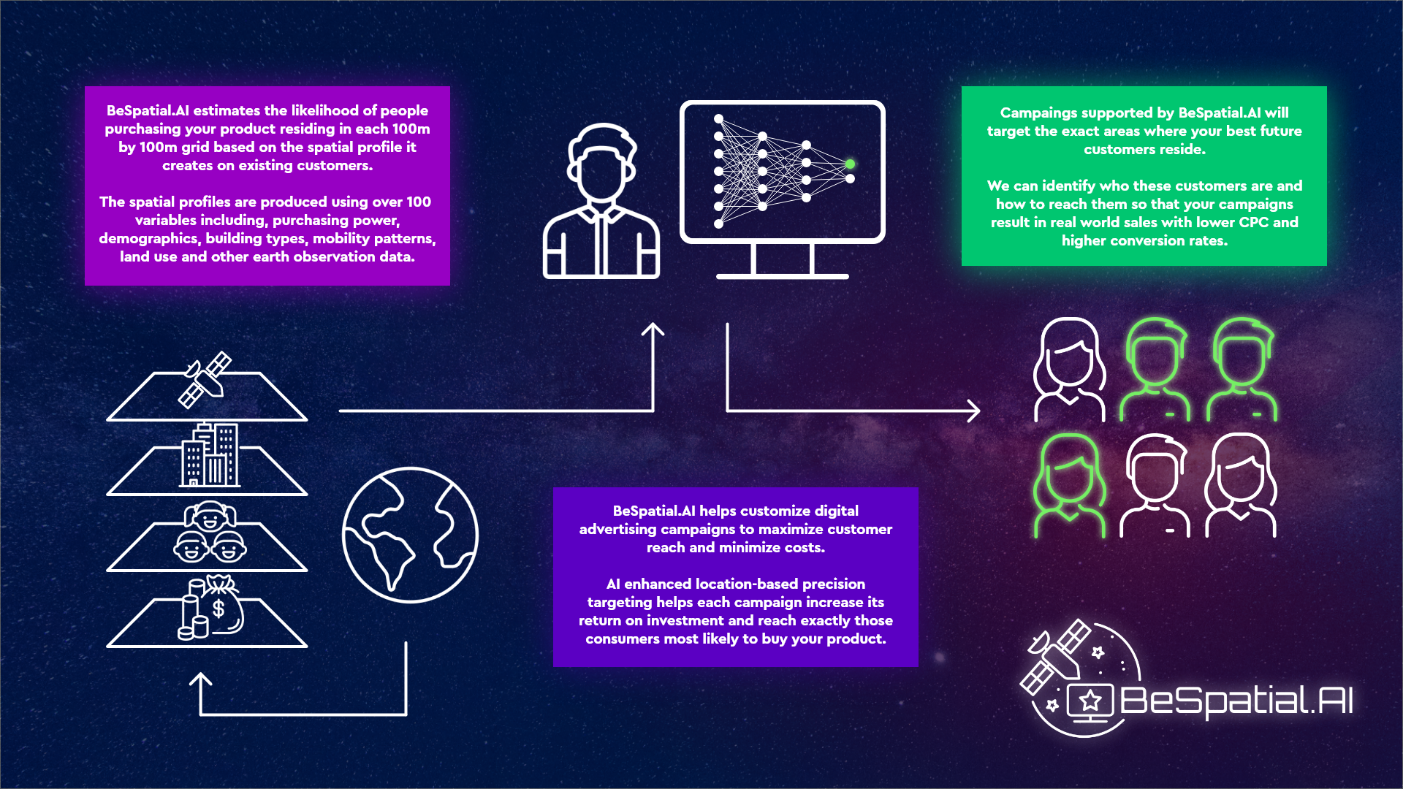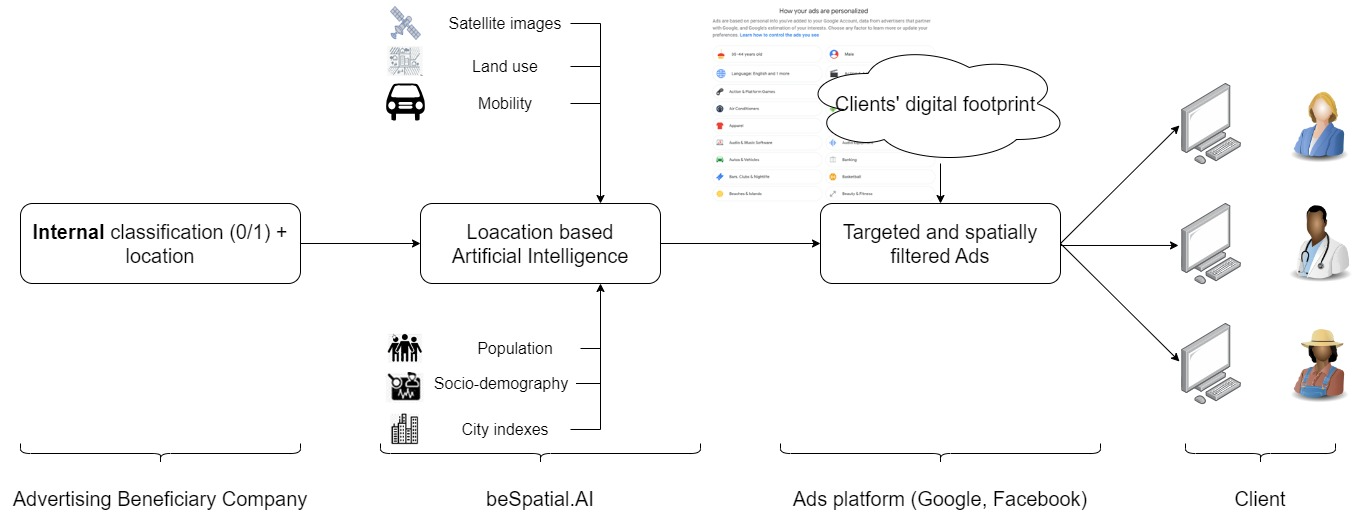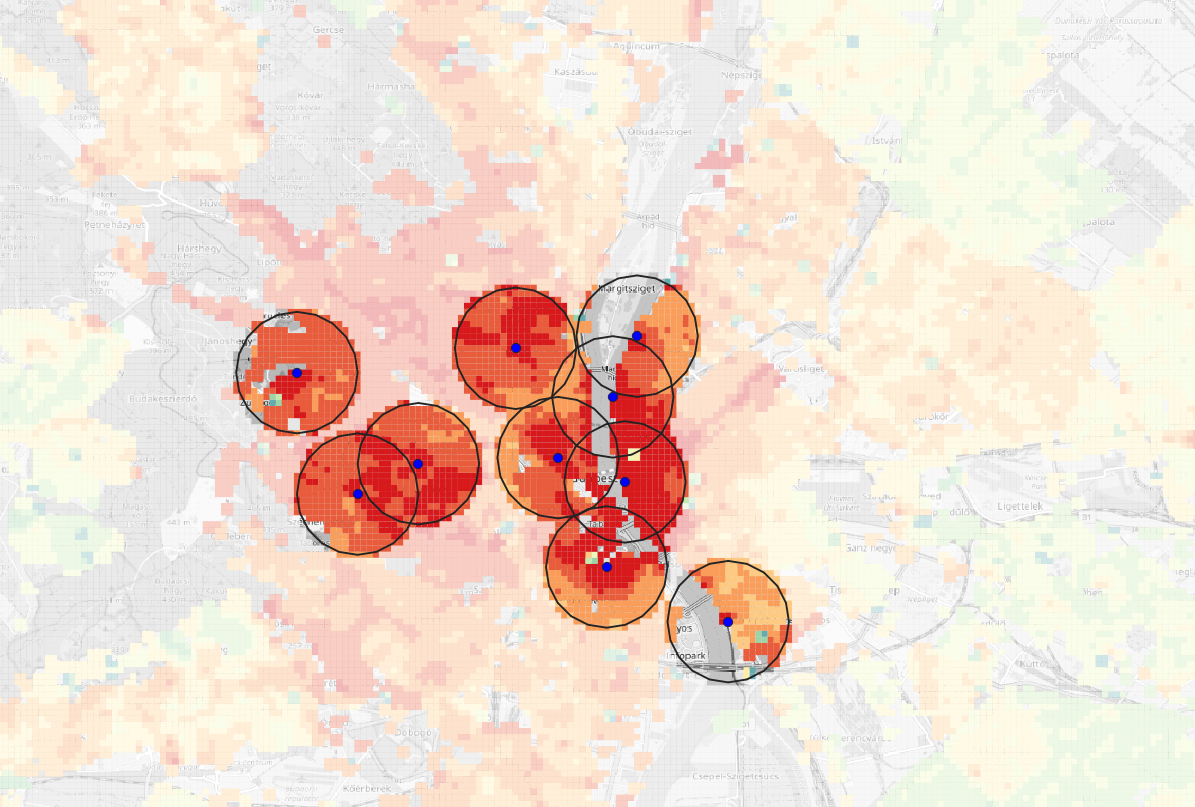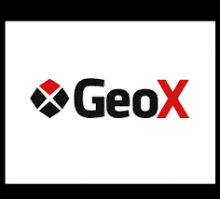
Objectives of the service

BeSpatialAI provides a solution for advertisers to leverage Earth Observation and geodemographic data assets to increase advertisement targeting accuracy by identifying the best locations to target for digital and physical ads. BeSpatial.AI is based on customer density look-a-like patterns provided by an ensemble of machine learning algorithms trained on 103 layers from Satellite and GIS data.
Good vs bad location classification model accuracy reached 91% for a given customer in FSI industry. It is not a one size fits all solution. Each client has its own machine learning model trained by machine learning model.
BeSpatial.AI brings down ads location selection time from weeks to hours.
No whitespaces overlooked, less Cost per Click, higher conversion rates, higher return on ads spent.
Users and their needs
BeSpatialAI is a B2B service for B2C organizations. We are creating value for companies in the financial services and retail sectors through making their digital advertising efforts more efficient. Based on preliminary discussion with potential customers, the direct users of our product will be the departments responsible for sales and marketing across digital channels.
Advertisers are looking for tools to better target their messaging to reach their customers reduce CAC (Cost of Acquisition) increase CTR (Click Through Rate) and ROAS (Return on Ad Spent).
The current practice in digital campaign management is to A/B test targeting, however this is a time and resource-consuming process.
Often limited to creative and audience selection. Locations are rarely part of test matrixes.
BeSpatial.AI enhances targeting accuracy based on geolocational similarity AI models and customer affinity maps.
In our test campaigns we could multiply CTR, Time Spent on Site, ROAS. By finding the best locations to target based on BeSpatial.AI targeting.
Automated MLOPS process doesn’t require man months of scarce internal resources (IT, BI, DataScience, CRM) involvement.
Service/ system concept
BeSpatial.AI provides the locations to our customers where they are the most likely to reach their target audience so they can target their advertising efforts more efficiently.
The system does this by analysing – through the use of Artificial Intelligence - the locations of existing customers and finding new locations that have similar spatial characteristics. When doing the analysis and comparison the system takes into account very large numbers of variables that can be used to describe a given location. These can include sociodemographic variables, land use, mobility patterns, distances from POIs, earth observation data, housing types, etc.

Space Added Value
In the project the following space asset-based data sources were used:
-
Sentinel-2 remote sensing data,
-
Copernicus Land Monitoring Service data sets.
This type of utilization of the space assets is a new approach, different from the “traditional” agricultural, environmental, and land use change usage of remote sensing data.
Space assets were used with the expectation that they will enhance the overall predictive power of the model and increase accuracy. In practice this has been proven correct. The space asset based variables have a significant contribution in the performance of the model.
The Sentinel-2 based indices have significant additional power in the model besides the traditional ones.
Besides this, the Sentinel-2 based indices can be used to predict population and building types in countries where these variables are unavailable.
The initial version of our model also confirmed that space assets can also be used as a substitute for certain data types increasing scalability and facilitating entry in new markets in the future.
Current Status

Areas of maximum product affinity per population for Google/Meta ads campaigns
Our project journey has been marked by significant successes across multiple fronts. We've not only achieved our core technical and financial objectives but have actually surpassed our initial value delivery expectations.
The primary goal of BeSpatial.AI was to develop a solution that integrates Earth Observation (EO) data, socio-economic information, and advanced AI modelling to improve the ROI of digital advertising. This objective was achieved with remarkable results:
Enhanced Targeting Accuracy: Analyzing over 103 unique geolocation attributes per 100x100-meter cell, BeSpatial.AI enables highly precise targeting, drawing insights from demographic, environmental, and satellite data.
Proven Advertising Performance: Pilot campaigns demonstrated up to 24% higher click-through rates, 48% lower cost per click, and a 35% increase in return on ad spend compared to traditional national targeting. The best location circle identified by BeSpaitial.AI performed 16 times better than the worst control-group circle in an A/B test. BeSpatial.AI achieved a 91% accuracy rate in identifying high-potential areas for marketing, underscoring its efficacy.
Versatile Use Across Channels: Originally developed for digital ad optimization, BeSpatial.AI’s location intelligence has proven equally effective for offline marketing (e.g., billboards, direct mail, and retail planning), coupon services, and e-commerce offering broad applicability and value to clients in diverse sectors.
On the technical front, we've made some interesting trade-offs. While we've successfully reduced the running operating costs associated with our custom AI development, we made a strategic decision to enhance our Explainable AI capabilities. Rather than sticking with the originally planned static images, we developed an interactive module, based on customer feedback. Though this led to higher costs than initially budgeted, the improved functionality has proven to be a worthwhile investment.
The project has also validated our initial insight that there is much room for improvement in the geographic targeting of digital ads. Potential clients immediately understood the added value of location-based targeting, and our data-driven approach for better accuracy resonated well with end-users. Space assets in the form of Earth Observation data made a significant contribution to model accuracy and their addition - while groundbreaking - proved to be a seamless expansion of spatial data sources.
Perhaps most exciting is our international expansion journey. We've begun promising discussions in external markets, gaining valuable insights along the way. Our experiences implementing solutions in Italy, France, and Germany have taught us crucial lessons about adapting our product for different markets. This groundwork has facilitated expansion plans and improved the platform’s flexibility.
Prime Contractor(s)
Subcontractor(s)



